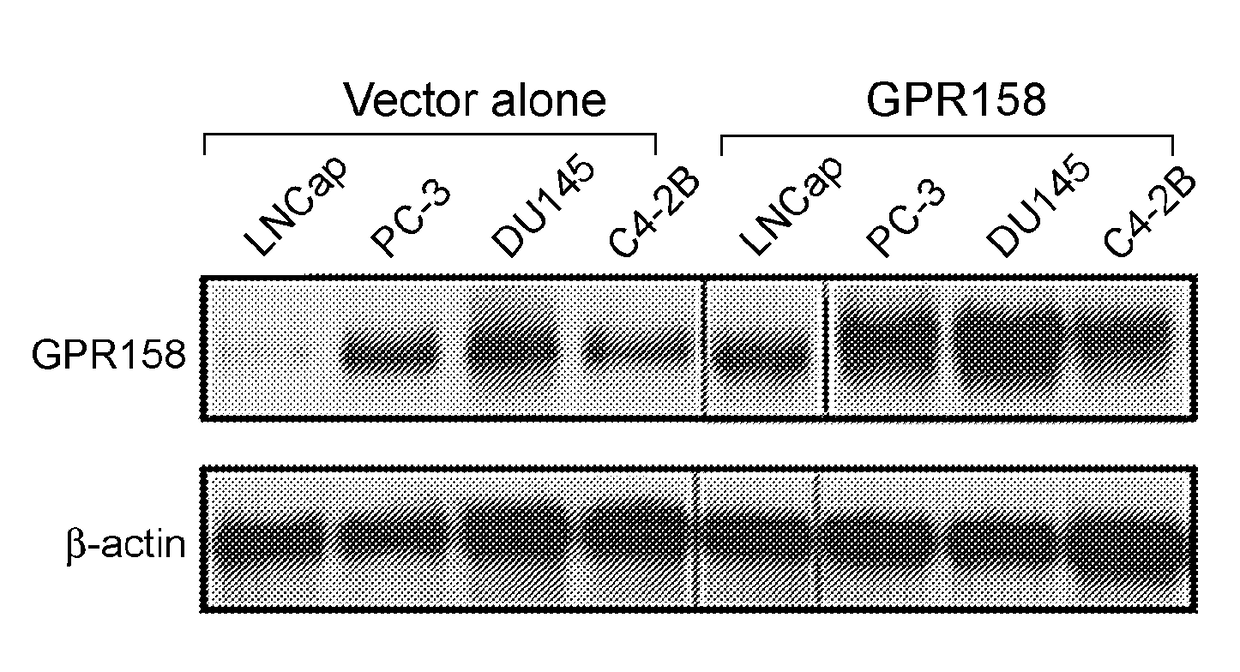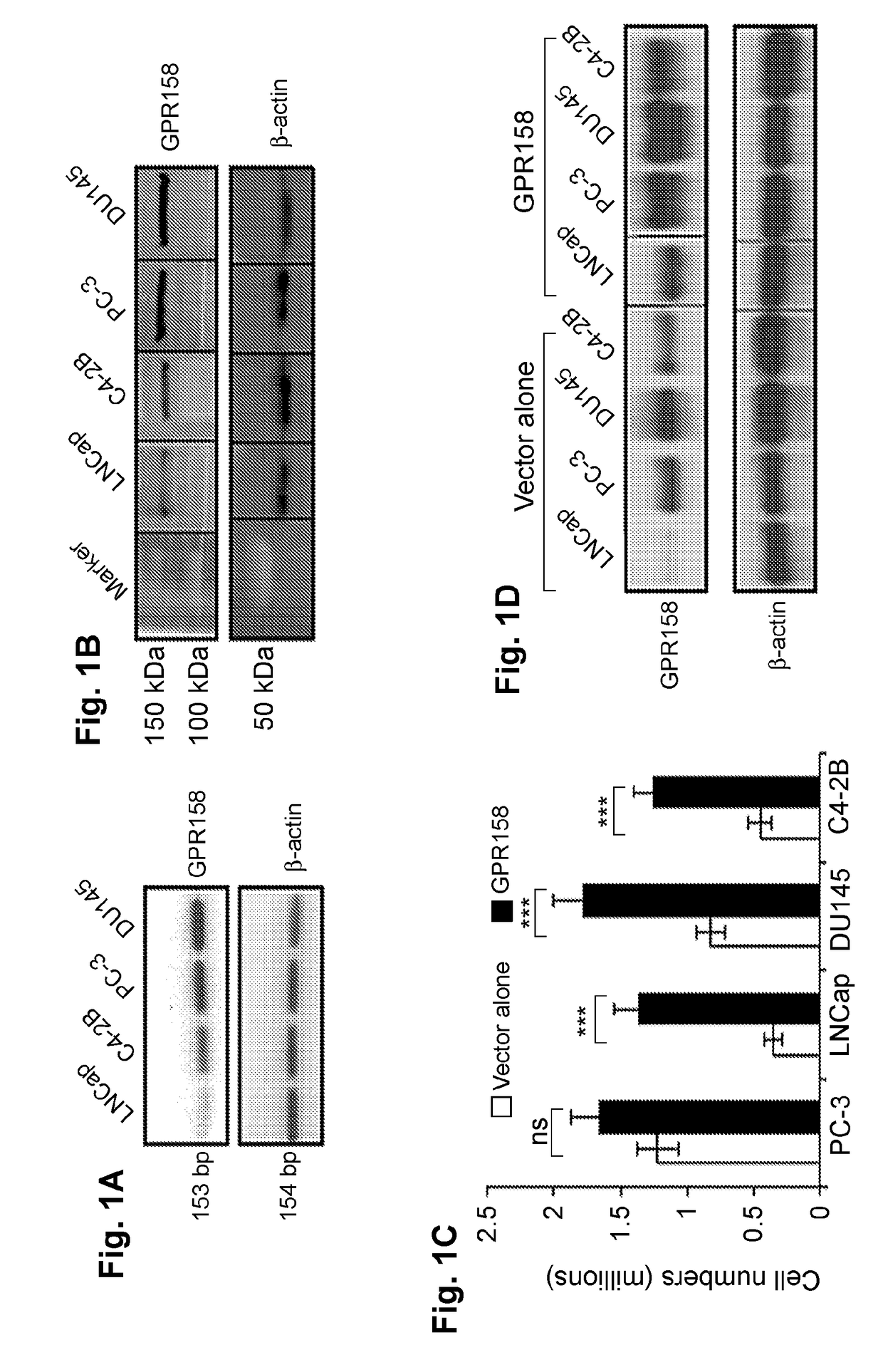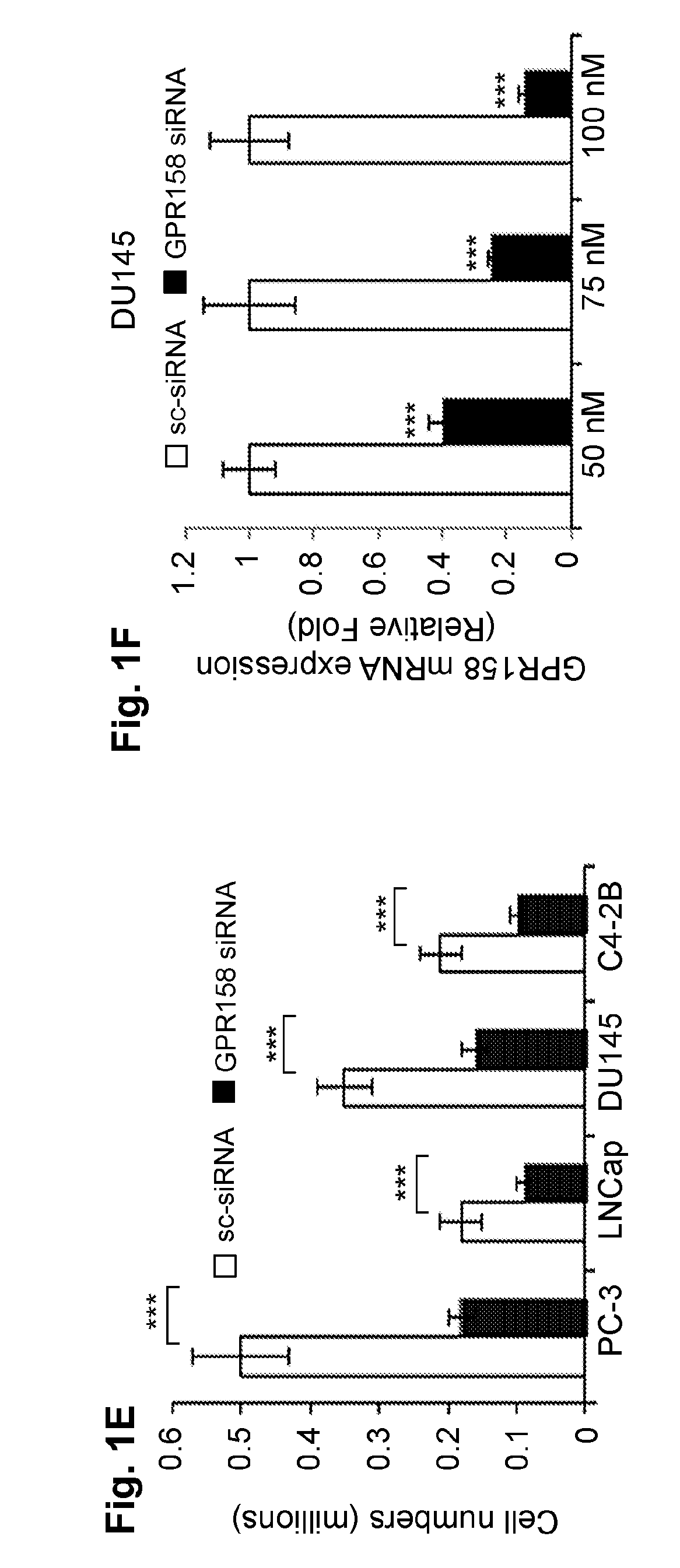Biotherapeutics targeting gpr158 for cancer
a cancer and biotechnology technology, applied in the field of biotherapeutics targeting gpr158 for cancer, to achieve the effect of increasing the mrna level of gpr158, increasing the cell proliferation rate, and increasing the proliferation ra
- Summary
- Abstract
- Description
- Claims
- Application Information
AI Technical Summary
Benefits of technology
Problems solved by technology
Method used
Image
Examples
example 1
Cell Culture
[0031]Primary human prostate epithelial cells (PHPECs) were purchased from the American Type Culture Collection (ATCC, Manassas, Va.) and maintained, as per their instructions, using the prostate epithelial cell basal medium containing cell growth kit. Four human PCa cell lines maintained in one of the Inventors' labs (Coetzee) were used in these studies: LNCaP, C4-2B, PC-3 and DU145, all obtained originally from the ATCC. LNCaP and C4-2B cells were cultured in complete RPMI medium, while DU145 and PC-3 cells were grown in DMEM medium (Gibco-BRL, Bethesda, Mass.), both containing 10% fetal calf serum (FCS) at 5% CO2 at 37° C. The cells were split every 3 days.
[0032]The LNCaP cell line was established from a human lymph node metastatic lesion of prostatic adenocarcinoma. LNCaP cells express the AR carrying the common T877A mutation in the ligand-binding domain, creating broad steroid binding specificity. They are androgen-responsive, displaying growth stimulation when tre...
example 2
Reagents and Oligonucleotide Primers
[0034]The reagents used in the study were purchased as follows: lipofectamine LTX with PLUS reagent (Invitrogen, Carlsbad, Calif.); primary antibodies to the AR, prostate specific antigen (PSA), neuron specific enolase (NSE), epidermal growth factor receptor (EGFR) and transcription factor Sp1, and horseradish peroxidase-conjugated secondary antibodies (Santa Cruz Biotechnology, Santa Cruz, Calif.); anti-intracellular domain (ICD) and anti-extracellular domain (ECD) GPR158 antibodies and anti-alpha-tubulin antibodies (Sigma-Aldrich Corp., St. Louis, Mo.); anti-beta-actin antibody (Abcam, Cambridge, UK); high-Fidelity DNA polymerase, Phusion (Finnzymes Inc., Woburn, Mass.); oligonucleotides primers (Valuegene INC, San Diego, Calif.); charcoal stripped fetal bovine serum (Atlanta Biologicals Inc., Lawrenceville, Ga.). All other reagents were purchased from Sigma. Table 1 provides the sequences of all oligonucleotides primers used in this study. For ...
example 3
Quantitative Real-Time Reverse Transcription-PCR (qRT-PCR)
[0035]Total RNA isolated from PCa cell lines with Aurum total RNA mini kit (Bio-Rad, Hercules, Calif.) was subjected to qRT-PCR analysis using iScript one-step RT-PCR kit with SYBR Green (Bio-Rad) on CFX96 Touch Real-Time PCR Detection System (Bio-Rad), according to the manufacturer's instructions. Relative quantification values of genes of interest were calculated as 2−ΔΔCt by the comparative Ct method, where ΔΔCt=(Ct target mRNA of treated sample-Ct reference gene of treated sample)-(Ct target mRNA of control sample-Ct reference gene of control sample). The Inventors used beta-actin or GAPDH as a reference gene. The primers used for the estimation of GPR158, AR, PSA and NSE expression are shown in Table 1.
PUM
| Property | Measurement | Unit |
|---|---|---|
| concentration | aaaaa | aaaaa |
| concentration | aaaaa | aaaaa |
| median survival time | aaaaa | aaaaa |
Abstract
Description
Claims
Application Information
 Login to View More
Login to View More - R&D
- Intellectual Property
- Life Sciences
- Materials
- Tech Scout
- Unparalleled Data Quality
- Higher Quality Content
- 60% Fewer Hallucinations
Browse by: Latest US Patents, China's latest patents, Technical Efficacy Thesaurus, Application Domain, Technology Topic, Popular Technical Reports.
© 2025 PatSnap. All rights reserved.Legal|Privacy policy|Modern Slavery Act Transparency Statement|Sitemap|About US| Contact US: help@patsnap.com



